Ulcerative Colitis Case Study: Patient History, Symptoms & Treatment
VerifiedAdded on 2023/04/06
|7
|1369
|364
Case Study
AI Summary
This case study examines a 48-year-old patient, Eleanor Brown, with a history of ulcerative colitis, focusing on her recent hospital admission due to an acute exacerbation. The analysis covers the patient's symptoms, including severe diarrhea with blood and pus, abdominal pain, and bloating. It explores the underlying causes of weight loss associated with ulcerative colitis, such as persistent diarrhea, abdominal pain, and changes in hormones like leptin and ghrelin. The study also discusses the pain pathway and the use of morphine for pain management. Furthermore, it addresses the patient's electrolyte imbalance and the rationale for administering Hetmans solution (Ringers Lactate) to restore fluid and electrolyte balance due to blood loss and frequent diarrhea. The case emphasizes the importance of addressing both the inflammation and the nutritional needs of patients with ulcerative colitis. Desklib offers similar case studies and solved assignments for students.
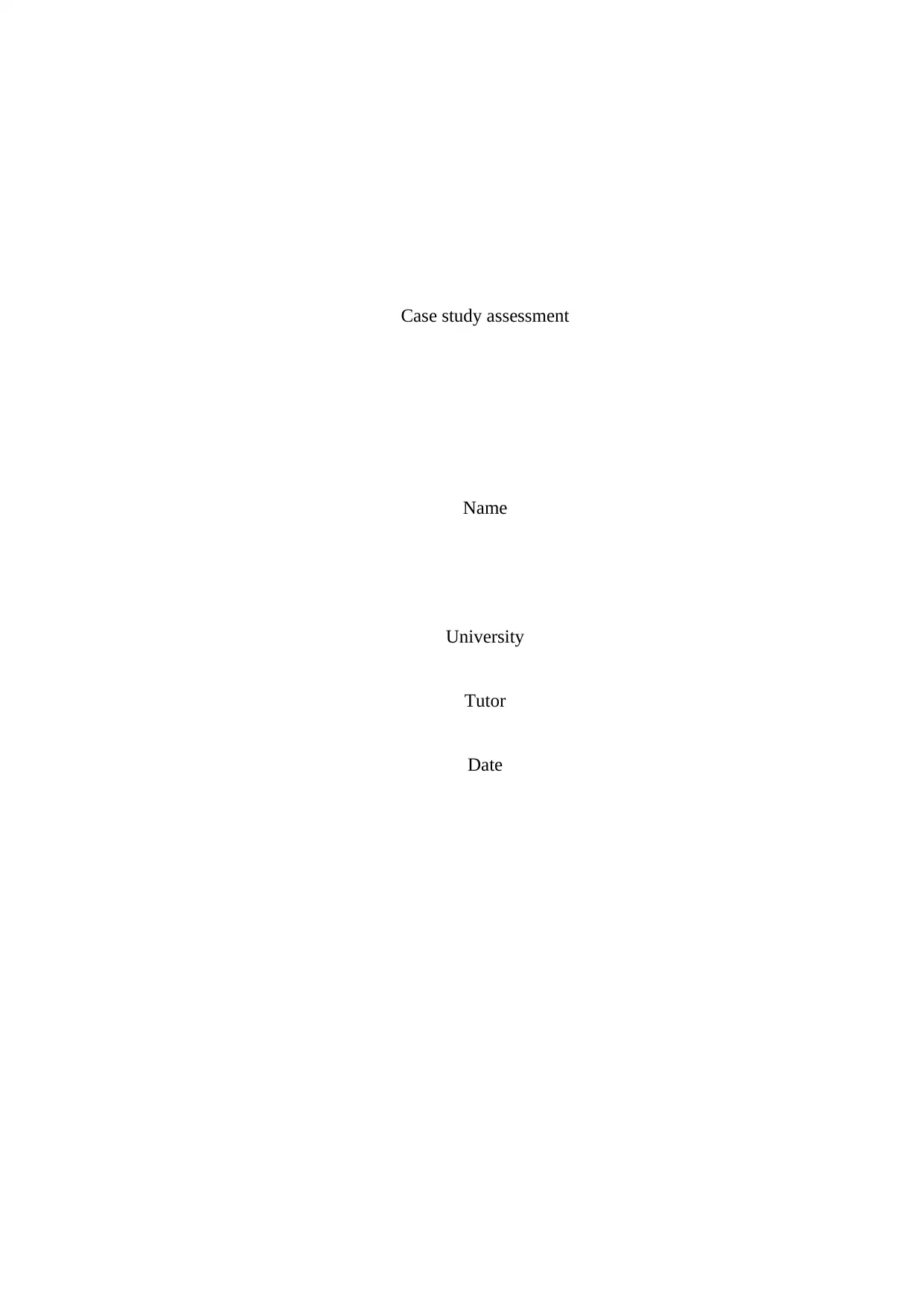
Case study assessment
Name
University
Tutor
Date
Name
University
Tutor
Date
Paraphrase This Document
Need a fresh take? Get an instant paraphrase of this document with our AI Paraphraser
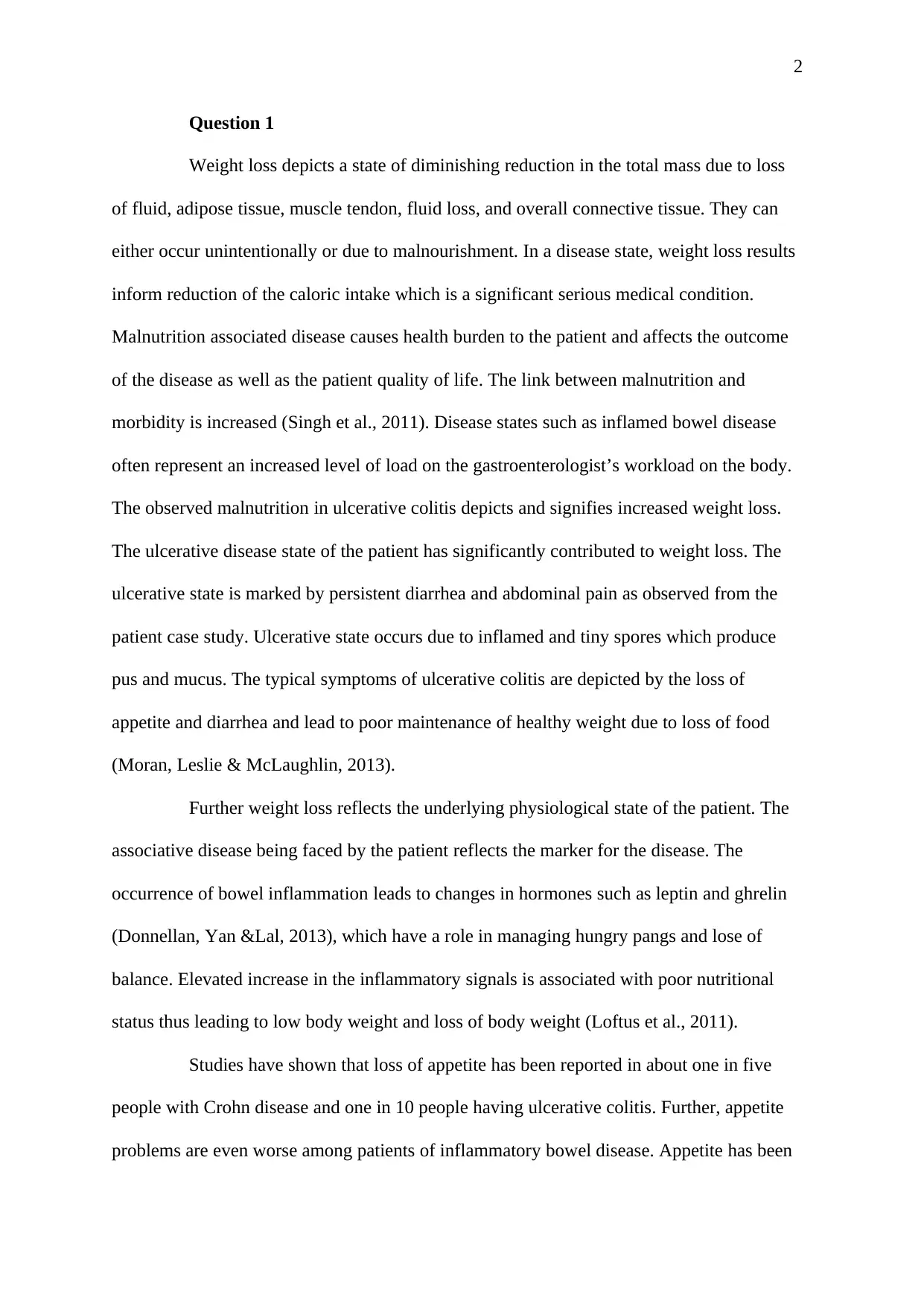
2
Question 1
Weight loss depicts a state of diminishing reduction in the total mass due to loss
of fluid, adipose tissue, muscle tendon, fluid loss, and overall connective tissue. They can
either occur unintentionally or due to malnourishment. In a disease state, weight loss results
inform reduction of the caloric intake which is a significant serious medical condition.
Malnutrition associated disease causes health burden to the patient and affects the outcome
of the disease as well as the patient quality of life. The link between malnutrition and
morbidity is increased (Singh et al., 2011). Disease states such as inflamed bowel disease
often represent an increased level of load on the gastroenterologist’s workload on the body.
The observed malnutrition in ulcerative colitis depicts and signifies increased weight loss.
The ulcerative disease state of the patient has significantly contributed to weight loss. The
ulcerative state is marked by persistent diarrhea and abdominal pain as observed from the
patient case study. Ulcerative state occurs due to inflamed and tiny spores which produce
pus and mucus. The typical symptoms of ulcerative colitis are depicted by the loss of
appetite and diarrhea and lead to poor maintenance of healthy weight due to loss of food
(Moran, Leslie & McLaughlin, 2013).
Further weight loss reflects the underlying physiological state of the patient. The
associative disease being faced by the patient reflects the marker for the disease. The
occurrence of bowel inflammation leads to changes in hormones such as leptin and ghrelin
(Donnellan, Yan &Lal, 2013), which have a role in managing hungry pangs and lose of
balance. Elevated increase in the inflammatory signals is associated with poor nutritional
status thus leading to low body weight and loss of body weight (Loftus et al., 2011).
Studies have shown that loss of appetite has been reported in about one in five
people with Crohn disease and one in 10 people having ulcerative colitis. Further, appetite
problems are even worse among patients of inflammatory bowel disease. Appetite has been
Question 1
Weight loss depicts a state of diminishing reduction in the total mass due to loss
of fluid, adipose tissue, muscle tendon, fluid loss, and overall connective tissue. They can
either occur unintentionally or due to malnourishment. In a disease state, weight loss results
inform reduction of the caloric intake which is a significant serious medical condition.
Malnutrition associated disease causes health burden to the patient and affects the outcome
of the disease as well as the patient quality of life. The link between malnutrition and
morbidity is increased (Singh et al., 2011). Disease states such as inflamed bowel disease
often represent an increased level of load on the gastroenterologist’s workload on the body.
The observed malnutrition in ulcerative colitis depicts and signifies increased weight loss.
The ulcerative disease state of the patient has significantly contributed to weight loss. The
ulcerative state is marked by persistent diarrhea and abdominal pain as observed from the
patient case study. Ulcerative state occurs due to inflamed and tiny spores which produce
pus and mucus. The typical symptoms of ulcerative colitis are depicted by the loss of
appetite and diarrhea and lead to poor maintenance of healthy weight due to loss of food
(Moran, Leslie & McLaughlin, 2013).
Further weight loss reflects the underlying physiological state of the patient. The
associative disease being faced by the patient reflects the marker for the disease. The
occurrence of bowel inflammation leads to changes in hormones such as leptin and ghrelin
(Donnellan, Yan &Lal, 2013), which have a role in managing hungry pangs and lose of
balance. Elevated increase in the inflammatory signals is associated with poor nutritional
status thus leading to low body weight and loss of body weight (Loftus et al., 2011).
Studies have shown that loss of appetite has been reported in about one in five
people with Crohn disease and one in 10 people having ulcerative colitis. Further, appetite
problems are even worse among patients of inflammatory bowel disease. Appetite has been
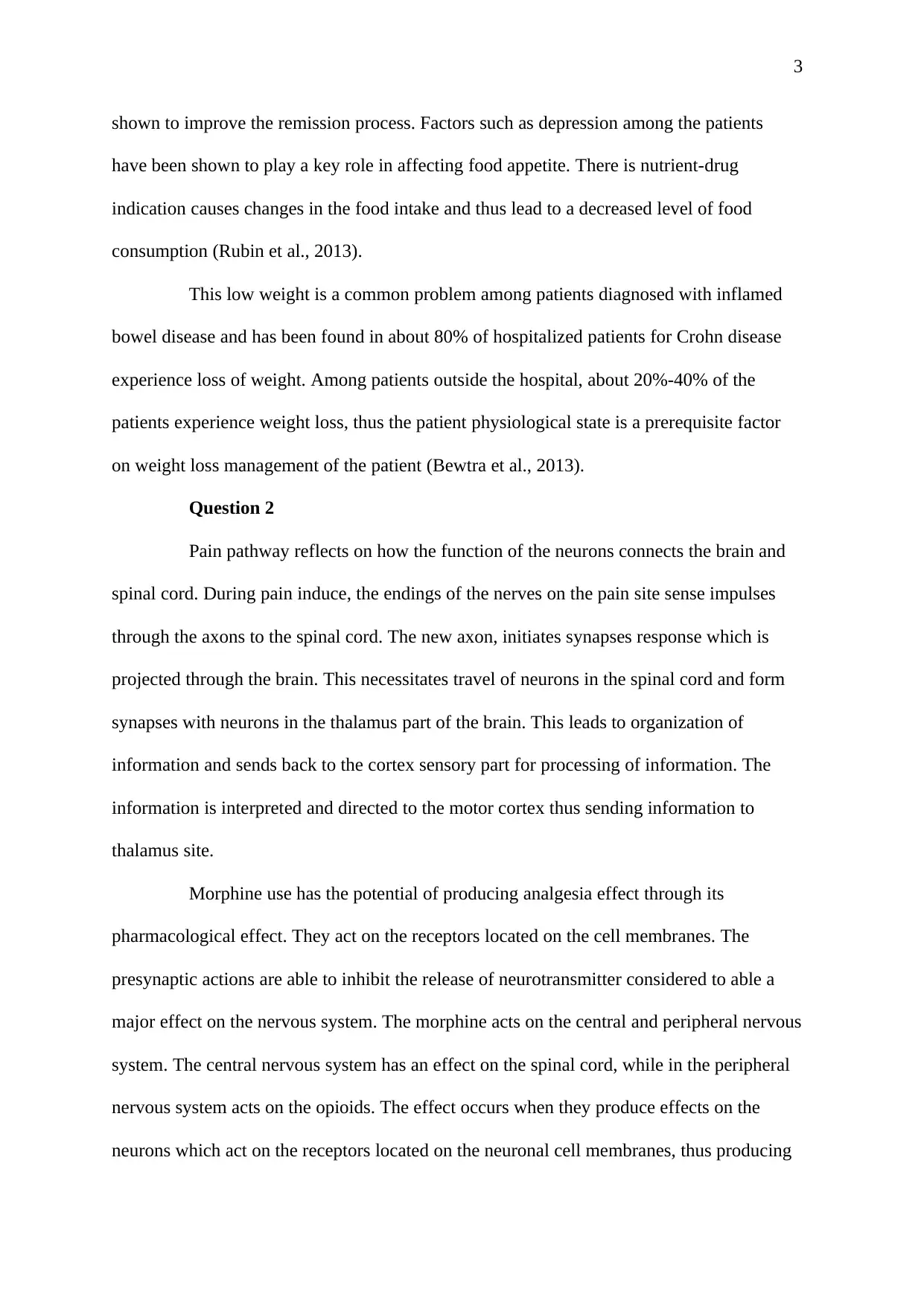
3
shown to improve the remission process. Factors such as depression among the patients
have been shown to play a key role in affecting food appetite. There is nutrient-drug
indication causes changes in the food intake and thus lead to a decreased level of food
consumption (Rubin et al., 2013).
This low weight is a common problem among patients diagnosed with inflamed
bowel disease and has been found in about 80% of hospitalized patients for Crohn disease
experience loss of weight. Among patients outside the hospital, about 20%-40% of the
patients experience weight loss, thus the patient physiological state is a prerequisite factor
on weight loss management of the patient (Bewtra et al., 2013).
Question 2
Pain pathway reflects on how the function of the neurons connects the brain and
spinal cord. During pain induce, the endings of the nerves on the pain site sense impulses
through the axons to the spinal cord. The new axon, initiates synapses response which is
projected through the brain. This necessitates travel of neurons in the spinal cord and form
synapses with neurons in the thalamus part of the brain. This leads to organization of
information and sends back to the cortex sensory part for processing of information. The
information is interpreted and directed to the motor cortex thus sending information to
thalamus site.
Morphine use has the potential of producing analgesia effect through its
pharmacological effect. They act on the receptors located on the cell membranes. The
presynaptic actions are able to inhibit the release of neurotransmitter considered to able a
major effect on the nervous system. The morphine acts on the central and peripheral nervous
system. The central nervous system has an effect on the spinal cord, while in the peripheral
nervous system acts on the opioids. The effect occurs when they produce effects on the
neurons which act on the receptors located on the neuronal cell membranes, thus producing
shown to improve the remission process. Factors such as depression among the patients
have been shown to play a key role in affecting food appetite. There is nutrient-drug
indication causes changes in the food intake and thus lead to a decreased level of food
consumption (Rubin et al., 2013).
This low weight is a common problem among patients diagnosed with inflamed
bowel disease and has been found in about 80% of hospitalized patients for Crohn disease
experience loss of weight. Among patients outside the hospital, about 20%-40% of the
patients experience weight loss, thus the patient physiological state is a prerequisite factor
on weight loss management of the patient (Bewtra et al., 2013).
Question 2
Pain pathway reflects on how the function of the neurons connects the brain and
spinal cord. During pain induce, the endings of the nerves on the pain site sense impulses
through the axons to the spinal cord. The new axon, initiates synapses response which is
projected through the brain. This necessitates travel of neurons in the spinal cord and form
synapses with neurons in the thalamus part of the brain. This leads to organization of
information and sends back to the cortex sensory part for processing of information. The
information is interpreted and directed to the motor cortex thus sending information to
thalamus site.
Morphine use has the potential of producing analgesia effect through its
pharmacological effect. They act on the receptors located on the cell membranes. The
presynaptic actions are able to inhibit the release of neurotransmitter considered to able a
major effect on the nervous system. The morphine acts on the central and peripheral nervous
system. The central nervous system has an effect on the spinal cord, while in the peripheral
nervous system acts on the opioids. The effect occurs when they produce effects on the
neurons which act on the receptors located on the neuronal cell membranes, thus producing
⊘ This is a preview!⊘
Do you want full access?
Subscribe today to unlock all pages.

Trusted by 1+ million students worldwide
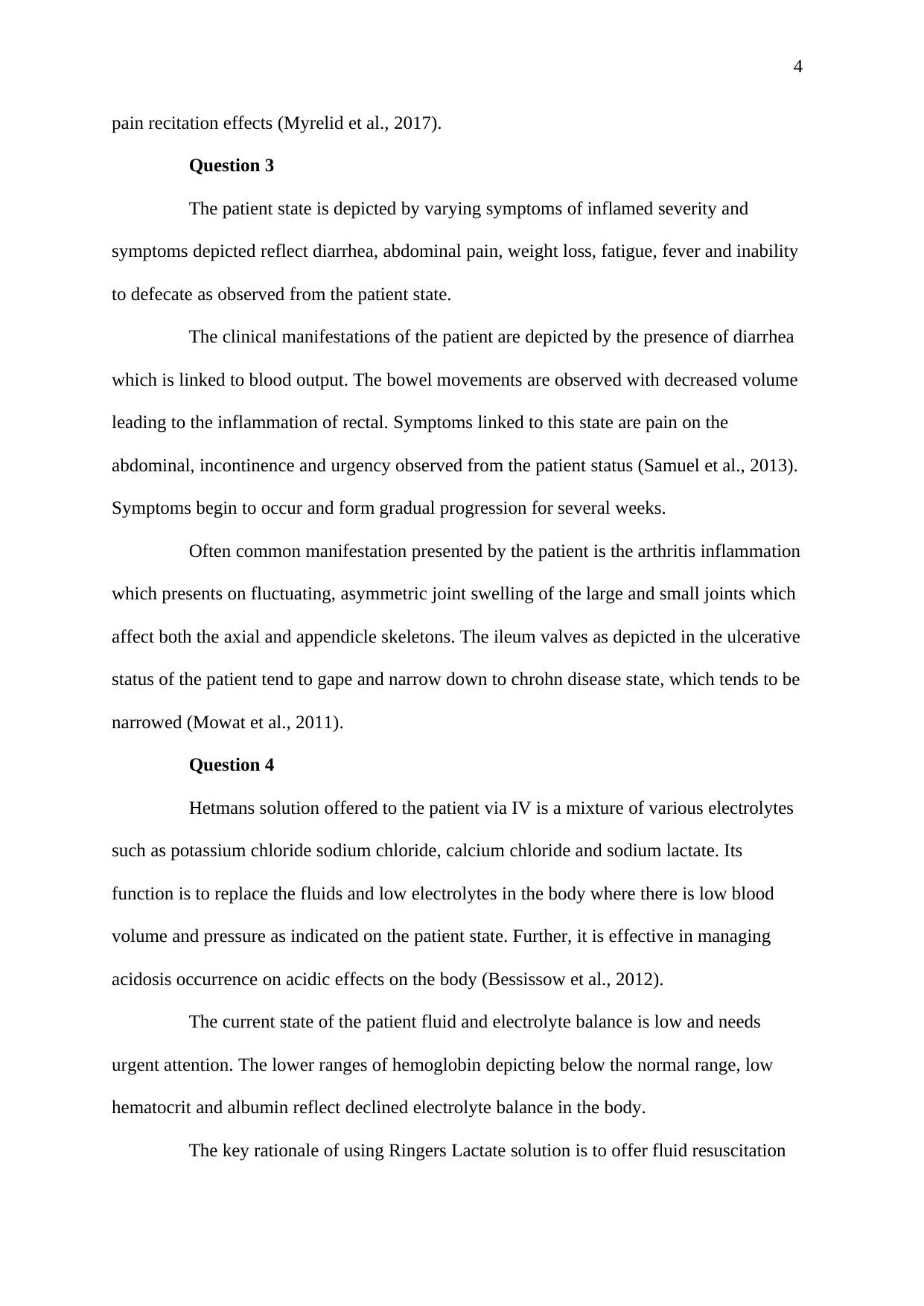
4
pain recitation effects (Myrelid et al., 2017).
Question 3
The patient state is depicted by varying symptoms of inflamed severity and
symptoms depicted reflect diarrhea, abdominal pain, weight loss, fatigue, fever and inability
to defecate as observed from the patient state.
The clinical manifestations of the patient are depicted by the presence of diarrhea
which is linked to blood output. The bowel movements are observed with decreased volume
leading to the inflammation of rectal. Symptoms linked to this state are pain on the
abdominal, incontinence and urgency observed from the patient status (Samuel et al., 2013).
Symptoms begin to occur and form gradual progression for several weeks.
Often common manifestation presented by the patient is the arthritis inflammation
which presents on fluctuating, asymmetric joint swelling of the large and small joints which
affect both the axial and appendicle skeletons. The ileum valves as depicted in the ulcerative
status of the patient tend to gape and narrow down to chrohn disease state, which tends to be
narrowed (Mowat et al., 2011).
Question 4
Hetmans solution offered to the patient via IV is a mixture of various electrolytes
such as potassium chloride sodium chloride, calcium chloride and sodium lactate. Its
function is to replace the fluids and low electrolytes in the body where there is low blood
volume and pressure as indicated on the patient state. Further, it is effective in managing
acidosis occurrence on acidic effects on the body (Bessissow et al., 2012).
The current state of the patient fluid and electrolyte balance is low and needs
urgent attention. The lower ranges of hemoglobin depicting below the normal range, low
hematocrit and albumin reflect declined electrolyte balance in the body.
The key rationale of using Ringers Lactate solution is to offer fluid resuscitation
pain recitation effects (Myrelid et al., 2017).
Question 3
The patient state is depicted by varying symptoms of inflamed severity and
symptoms depicted reflect diarrhea, abdominal pain, weight loss, fatigue, fever and inability
to defecate as observed from the patient state.
The clinical manifestations of the patient are depicted by the presence of diarrhea
which is linked to blood output. The bowel movements are observed with decreased volume
leading to the inflammation of rectal. Symptoms linked to this state are pain on the
abdominal, incontinence and urgency observed from the patient status (Samuel et al., 2013).
Symptoms begin to occur and form gradual progression for several weeks.
Often common manifestation presented by the patient is the arthritis inflammation
which presents on fluctuating, asymmetric joint swelling of the large and small joints which
affect both the axial and appendicle skeletons. The ileum valves as depicted in the ulcerative
status of the patient tend to gape and narrow down to chrohn disease state, which tends to be
narrowed (Mowat et al., 2011).
Question 4
Hetmans solution offered to the patient via IV is a mixture of various electrolytes
such as potassium chloride sodium chloride, calcium chloride and sodium lactate. Its
function is to replace the fluids and low electrolytes in the body where there is low blood
volume and pressure as indicated on the patient state. Further, it is effective in managing
acidosis occurrence on acidic effects on the body (Bessissow et al., 2012).
The current state of the patient fluid and electrolyte balance is low and needs
urgent attention. The lower ranges of hemoglobin depicting below the normal range, low
hematocrit and albumin reflect declined electrolyte balance in the body.
The key rationale of using Ringers Lactate solution is to offer fluid resuscitation
Paraphrase This Document
Need a fresh take? Get an instant paraphrase of this document with our AI Paraphraser
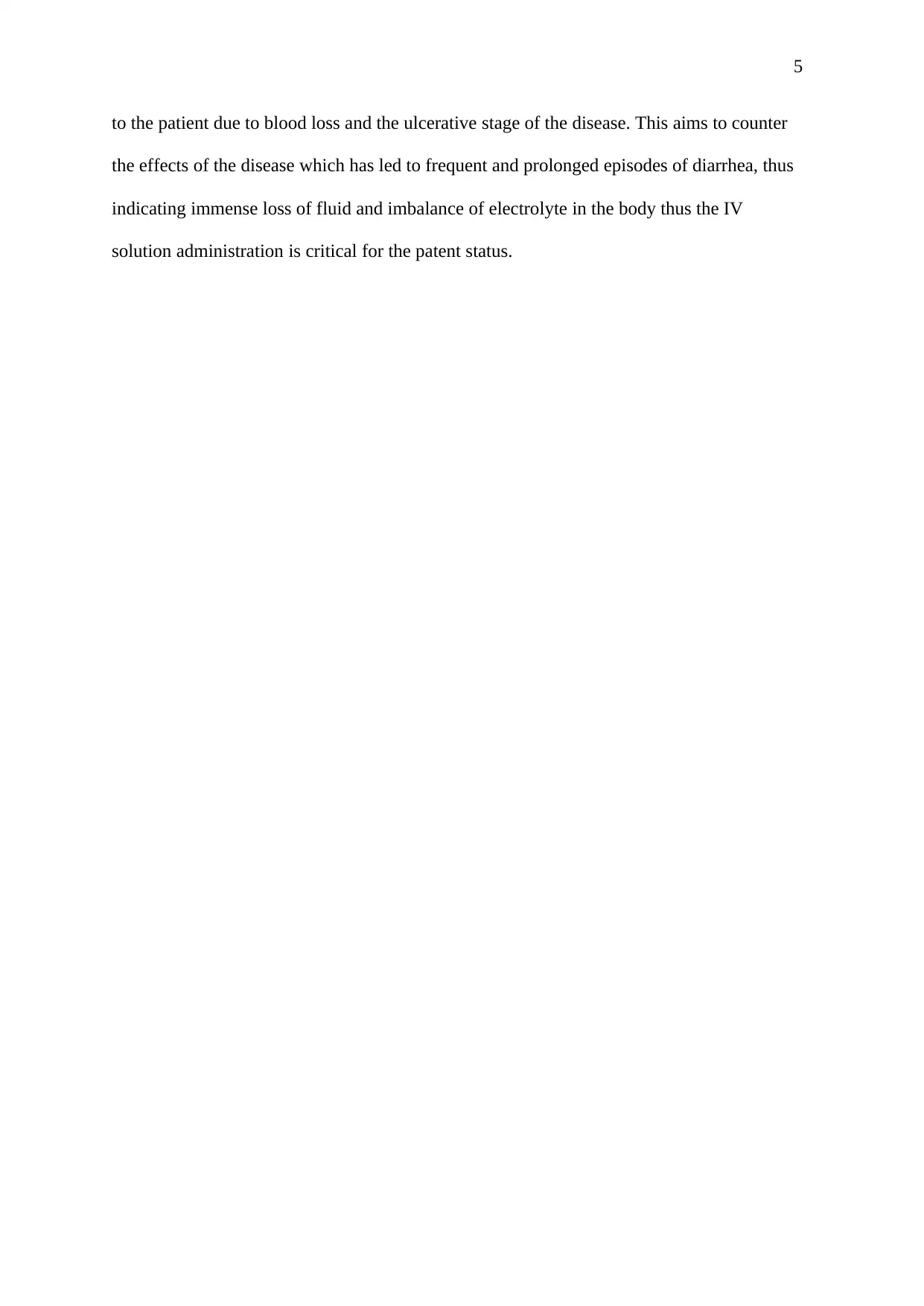
5
to the patient due to blood loss and the ulcerative stage of the disease. This aims to counter
the effects of the disease which has led to frequent and prolonged episodes of diarrhea, thus
indicating immense loss of fluid and imbalance of electrolyte in the body thus the IV
solution administration is critical for the patent status.
to the patient due to blood loss and the ulcerative stage of the disease. This aims to counter
the effects of the disease which has led to frequent and prolonged episodes of diarrhea, thus
indicating immense loss of fluid and imbalance of electrolyte in the body thus the IV
solution administration is critical for the patent status.
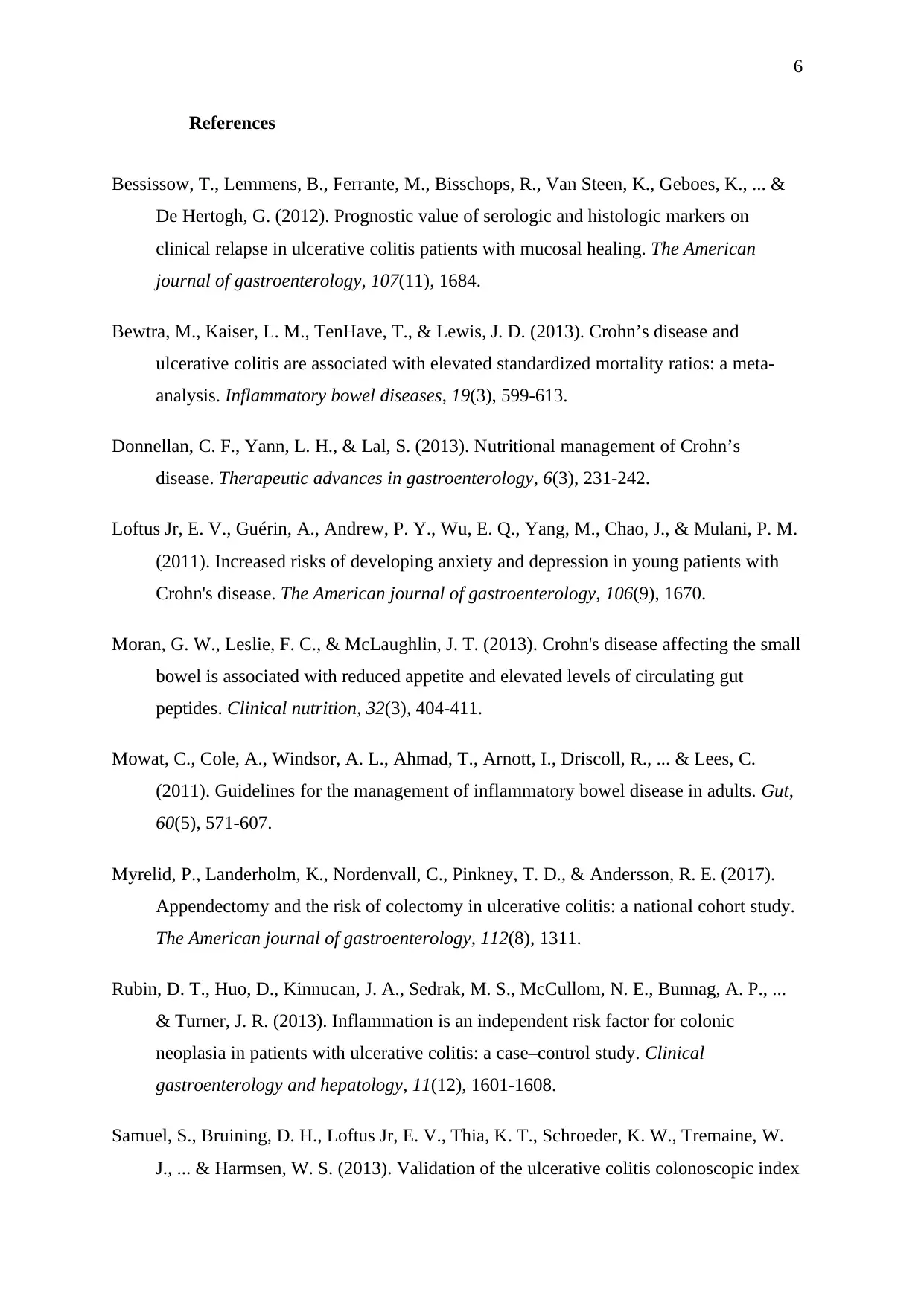
6
References
Bessissow, T., Lemmens, B., Ferrante, M., Bisschops, R., Van Steen, K., Geboes, K., ... &
De Hertogh, G. (2012). Prognostic value of serologic and histologic markers on
clinical relapse in ulcerative colitis patients with mucosal healing. The American
journal of gastroenterology, 107(11), 1684.
Bewtra, M., Kaiser, L. M., TenHave, T., & Lewis, J. D. (2013). Crohn’s disease and
ulcerative colitis are associated with elevated standardized mortality ratios: a meta-
analysis. Inflammatory bowel diseases, 19(3), 599-613.
Donnellan, C. F., Yann, L. H., & Lal, S. (2013). Nutritional management of Crohn’s
disease. Therapeutic advances in gastroenterology, 6(3), 231-242.
Loftus Jr, E. V., Guérin, A., Andrew, P. Y., Wu, E. Q., Yang, M., Chao, J., & Mulani, P. M.
(2011). Increased risks of developing anxiety and depression in young patients with
Crohn's disease. The American journal of gastroenterology, 106(9), 1670.
Moran, G. W., Leslie, F. C., & McLaughlin, J. T. (2013). Crohn's disease affecting the small
bowel is associated with reduced appetite and elevated levels of circulating gut
peptides. Clinical nutrition, 32(3), 404-411.
Mowat, C., Cole, A., Windsor, A. L., Ahmad, T., Arnott, I., Driscoll, R., ... & Lees, C.
(2011). Guidelines for the management of inflammatory bowel disease in adults. Gut,
60(5), 571-607.
Myrelid, P., Landerholm, K., Nordenvall, C., Pinkney, T. D., & Andersson, R. E. (2017).
Appendectomy and the risk of colectomy in ulcerative colitis: a national cohort study.
The American journal of gastroenterology, 112(8), 1311.
Rubin, D. T., Huo, D., Kinnucan, J. A., Sedrak, M. S., McCullom, N. E., Bunnag, A. P., ...
& Turner, J. R. (2013). Inflammation is an independent risk factor for colonic
neoplasia in patients with ulcerative colitis: a case–control study. Clinical
gastroenterology and hepatology, 11(12), 1601-1608.
Samuel, S., Bruining, D. H., Loftus Jr, E. V., Thia, K. T., Schroeder, K. W., Tremaine, W.
J., ... & Harmsen, W. S. (2013). Validation of the ulcerative colitis colonoscopic index
References
Bessissow, T., Lemmens, B., Ferrante, M., Bisschops, R., Van Steen, K., Geboes, K., ... &
De Hertogh, G. (2012). Prognostic value of serologic and histologic markers on
clinical relapse in ulcerative colitis patients with mucosal healing. The American
journal of gastroenterology, 107(11), 1684.
Bewtra, M., Kaiser, L. M., TenHave, T., & Lewis, J. D. (2013). Crohn’s disease and
ulcerative colitis are associated with elevated standardized mortality ratios: a meta-
analysis. Inflammatory bowel diseases, 19(3), 599-613.
Donnellan, C. F., Yann, L. H., & Lal, S. (2013). Nutritional management of Crohn’s
disease. Therapeutic advances in gastroenterology, 6(3), 231-242.
Loftus Jr, E. V., Guérin, A., Andrew, P. Y., Wu, E. Q., Yang, M., Chao, J., & Mulani, P. M.
(2011). Increased risks of developing anxiety and depression in young patients with
Crohn's disease. The American journal of gastroenterology, 106(9), 1670.
Moran, G. W., Leslie, F. C., & McLaughlin, J. T. (2013). Crohn's disease affecting the small
bowel is associated with reduced appetite and elevated levels of circulating gut
peptides. Clinical nutrition, 32(3), 404-411.
Mowat, C., Cole, A., Windsor, A. L., Ahmad, T., Arnott, I., Driscoll, R., ... & Lees, C.
(2011). Guidelines for the management of inflammatory bowel disease in adults. Gut,
60(5), 571-607.
Myrelid, P., Landerholm, K., Nordenvall, C., Pinkney, T. D., & Andersson, R. E. (2017).
Appendectomy and the risk of colectomy in ulcerative colitis: a national cohort study.
The American journal of gastroenterology, 112(8), 1311.
Rubin, D. T., Huo, D., Kinnucan, J. A., Sedrak, M. S., McCullom, N. E., Bunnag, A. P., ...
& Turner, J. R. (2013). Inflammation is an independent risk factor for colonic
neoplasia in patients with ulcerative colitis: a case–control study. Clinical
gastroenterology and hepatology, 11(12), 1601-1608.
Samuel, S., Bruining, D. H., Loftus Jr, E. V., Thia, K. T., Schroeder, K. W., Tremaine, W.
J., ... & Harmsen, W. S. (2013). Validation of the ulcerative colitis colonoscopic index
⊘ This is a preview!⊘
Do you want full access?
Subscribe today to unlock all pages.

Trusted by 1+ million students worldwide
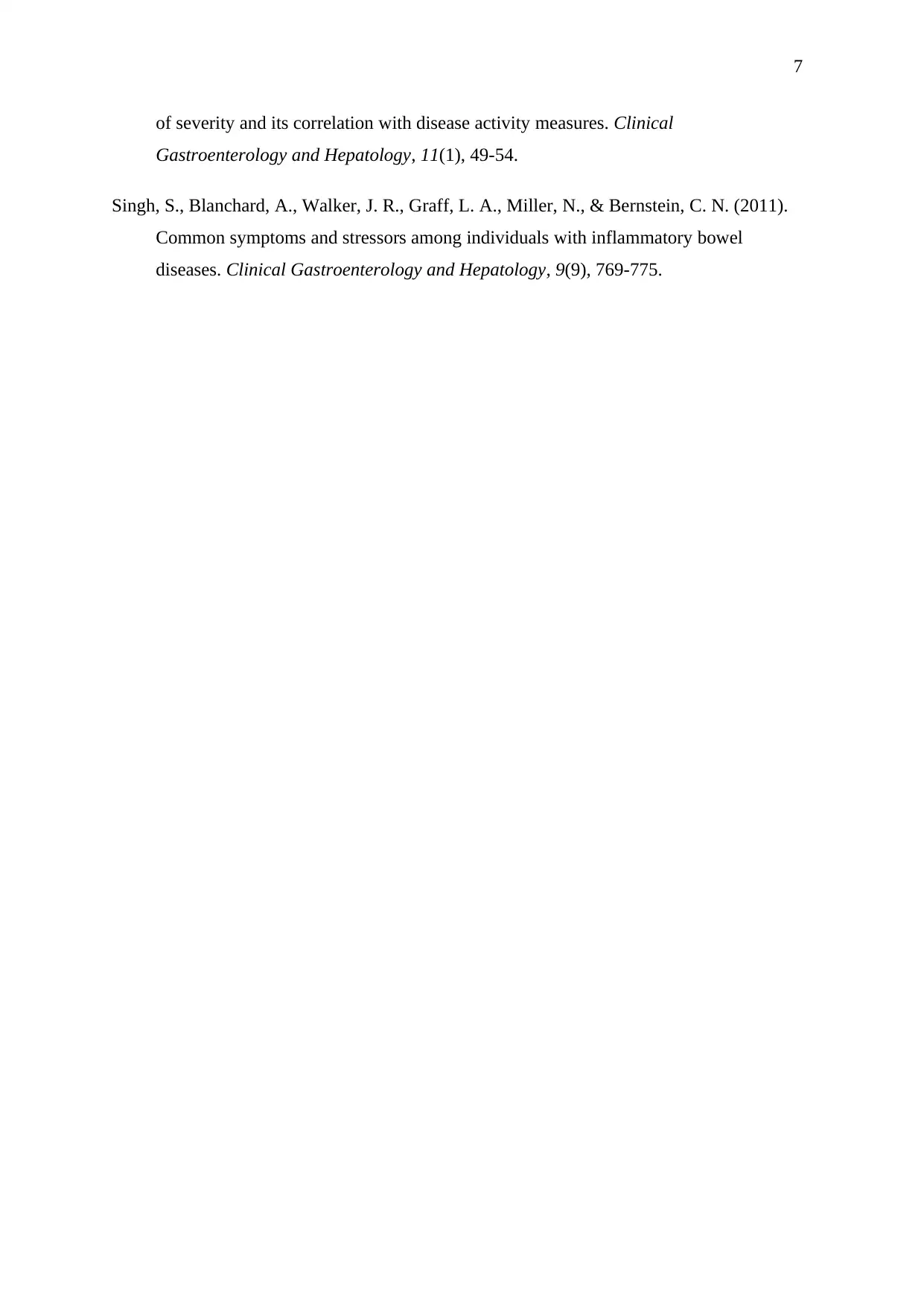
7
of severity and its correlation with disease activity measures. Clinical
Gastroenterology and Hepatology, 11(1), 49-54.
Singh, S., Blanchard, A., Walker, J. R., Graff, L. A., Miller, N., & Bernstein, C. N. (2011).
Common symptoms and stressors among individuals with inflammatory bowel
diseases. Clinical Gastroenterology and Hepatology, 9(9), 769-775.
of severity and its correlation with disease activity measures. Clinical
Gastroenterology and Hepatology, 11(1), 49-54.
Singh, S., Blanchard, A., Walker, J. R., Graff, L. A., Miller, N., & Bernstein, C. N. (2011).
Common symptoms and stressors among individuals with inflammatory bowel
diseases. Clinical Gastroenterology and Hepatology, 9(9), 769-775.
1 out of 7
Related Documents
Your All-in-One AI-Powered Toolkit for Academic Success.
+13062052269
info@desklib.com
Available 24*7 on WhatsApp / Email
![[object Object]](/_next/static/media/star-bottom.7253800d.svg)
Unlock your academic potential
Copyright © 2020–2025 A2Z Services. All Rights Reserved. Developed and managed by ZUCOL.





